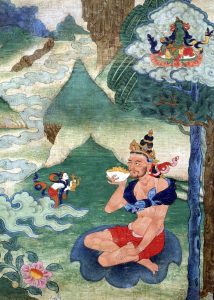
From “The Bliss of Inner Fire: Heart Practice of the Six Yogas of Naropa”
By Lama Yeshe
Part Four: Awaking the Vajra Body
Chapter 13: Channels and Chakras
Herein excerpts from subsection on “Sitting”
Inner fire meditation (Tummo, one of the Six Yogas of Naropa) enables the yogi or yogini to absorb all the energy-winds into the central channel, generate the four joys, and thus experience simultaneously born great blissful wisdom. This process leads to the union of the illusory body and clear light, and finally to full enlightenment.
One of the first practical steps we need to take to achieve this result is to learn about the structure of the vajra body, especially of the channels and chakras. We have to visualize them in meditation until we are totally familiar with them.
To prepare for visualizing the channels and chakras, we need to visualize our body as hollow, or empty. This meditation is simple but very important. When you do it well, there is less chance of experiencing difficulties later when you investigate the channels and chakras. First, however, I will discuss how to sit properly.
Tantra simply uses the natural resources of your body; it follows your own natural play of energy.
Correct body posture is very important during inner fire meditation.
Cross your legs into the full-lotus position.
Completion stage practices should be done in this position.
Your spine should be straight and your head bent slightly forward.
Half close your eyes, without focusing on anything, and look toward the tip of your nose. However, if your mind is very distracted and you cannot quiet it, you may find it helpful to close your eyes. Place the tip of your tongue against your palate just behind your front teeth, with your lower jaw relaxed. Your shoulders should be held back straight, not hunched forward. Your hands should be placed below your navel in the mudra of concentration, with the right one on top of the left and with your thumbs touching to form a triangle.
Visualize the main channels and chakras
…
Terms:
central channel. The most important of the thousands of channels of the subtle body. During inner fire meditation it is visualized as blue, as running just in front of the spine, and as starting at the brow chakra and ending four finger-widths below the navel.
clear light. Very subtle mind; the fourth empty; also refers to the object, emptiness, of the clear light mind; one of the Six Yogas of Naropa. This subtlest state of mind occurs naturally at death, for example, and through successful practice of inner fire, and is used by yogis and yoginis to realize nonduality. When achieved through meditation, this initial clear light is then perfected, becoming the actual clear light, which is unified with the pure illusory body to bring the accomplishment of enlightenment. See also four empties.
chakras (Skt). Literally, wheels. Formed by the branching of channels at various points along the central channel, the six main chakras are at the brow, crown, throat, heart, navel, and sex organ. The navel chakra is the primary focus during inner fire meditation.
channels. The 72,000 energy channels of the body, which, with the airs and the kundalini, constitute the subtle body, and which are worked with in such practices as inner fire.
four empties. Four subtle types of consciousness-the minds of white appearance, red increase, black near-attainment, and clear light- which occur naturally at death, for example, or as a result of successful inner fire meditation when the airs have absorbed in the central channel. These subtle minds are used by the yogi or yogini to realize nonduality.
four joys. Four blisses. Bliss consciousnesses generated by the yogi or yogini after the airs have absorbed in the central channel and heat has been generated through successful inner fire meditation, causing the kundalini at the crown to melt. It flows down the central channel to the throat, heart, navel, and secret chakras, culminating in the fourth joy, known as simultaneously born bliss. The four joys of the reverse order are experienced when the kundalini is brought back up through the chakras to the crown.
hatha yoga (Skt). The physical exercises known as the Six Magical Wheels taught in the Six Yogas of Naropa. These help the practitioner to succeed in inner fire meditation by removing the blockages that impede the flow of the energies in the channels. (I) vase breathing; (2) rotating like a wheel; (3) bending the body like a hook; (4) the mudra of “vajra binding,” throwing up in the air and dropping down; (5) straightening the spine like an arrow in the manner of a vomiting dog; and (6) shaking the entire body and stretching the body and joints to enable a smooth flow of blood in the arteries.
illusory body. A body made of subtle air energies in the form of a deity but white in color; one of the Six Yogas of Naropa. The yogi or yogini arises in an impure illusory body immediately after their initial experience of clear light and in a pure illusory body after the achievement of the actual clear light.
inner fire. In Tibetan, tummo; literally, brave female. This is the first of the Six Yogas of Naropa. A completion stage tantric meditation technique for bringing all the airs into the central channel, thus awakening the clear light mind. If successfully accomplished, the process can lead to enlightenment in one lifetime.
subtle body. Vajra body. The system of channels, airs, and kundalini drops within a human body.
subtle mind. The conceptual states of mind, such as anger, desire, and so forth.
Winds; energy-winds; vital energies; airs. Subtle energies that flow in the channels of the body, which enable the body to function and which are associated with the different levels of mind.


3 Replies to “Empty Body Meditation ”